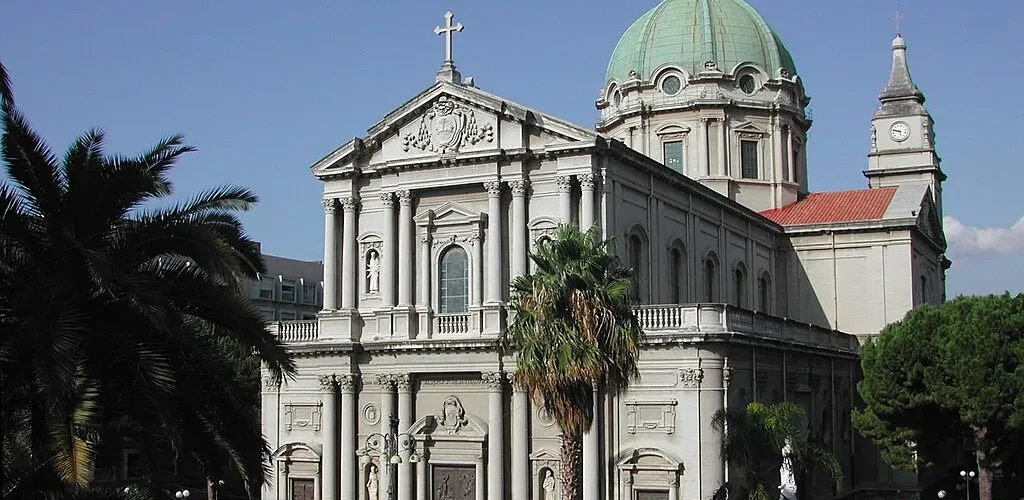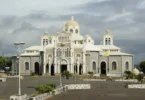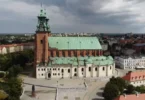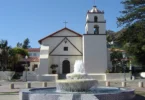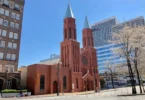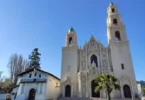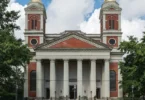Introduction
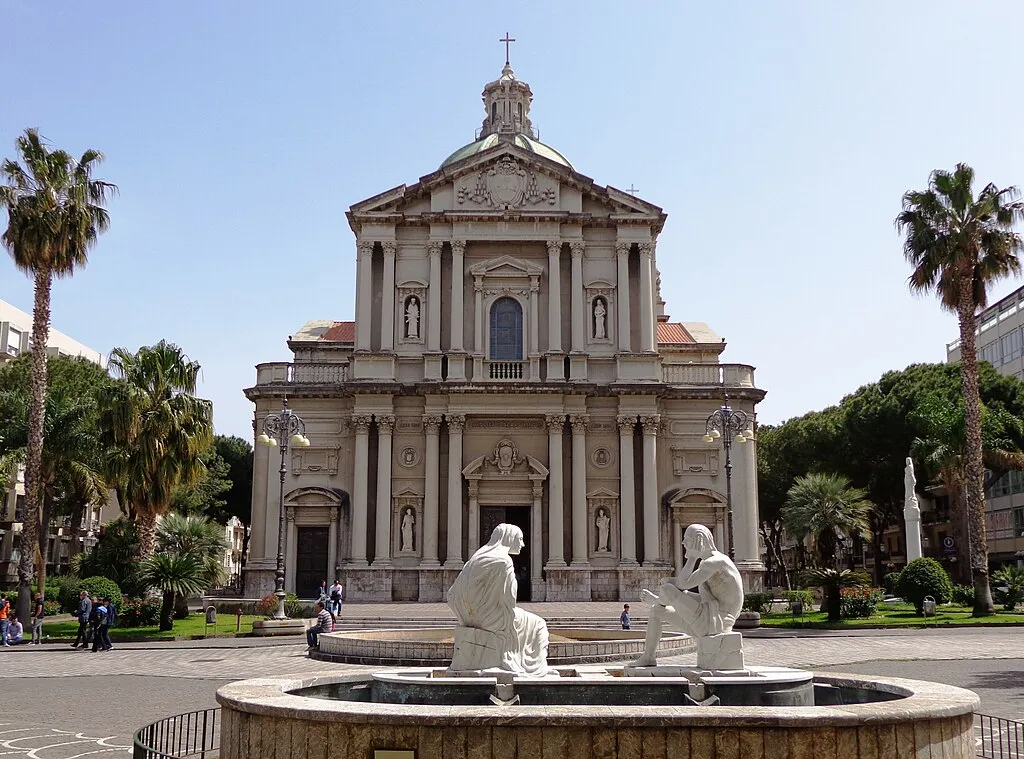
The Basilica of St. Sebastian (Italian: Basilica di San Sebastiano, also known as Duomo di Barcellona Pozzo di Gotto) is a significant Roman Catholic church located in Barcellona Pozzo di Gotto, a town in the province of Messina, Sicily, Italy. Elevated to the status of a minor basilica in 1991, it holds a prominent place within the region, both spiritually and architecturally. This grand structure is situated in the heart of the town, at Piazza Duomo, with its main façade facing Via Roma. The Basilica of St. Sebastian is not only the largest church in Barcellona Pozzo di Gotto but also the second-largest in the entire province of Messina, with only the Messina Cathedral surpassing it in size.
The current basilica was built in the 1930s, replacing a previous church that had stood on the same site. The construction of the new church was overseen by the engineer Francesco Barbaro, the nephew of Monsignor Barbaro, under whose guidance the works progressed. The construction was carried out by the Fratelli Cardillo firm, who had previously worked with Barbaro on the Shrine of Christ the King (Sacrario di Cristo Re) in Messina, another important religious landmark.
Although the Basilica of St. Sebastian is often referred to as the “cathedral of Barcellona Pozzo di Gotto,” it is important to note that Barcellona Pozzo di Gotto is not a bishopric, and thus the basilica does not serve as the seat of a bishop. Nevertheless, it holds great importance within the local community, serving as the center of the parish of San Sebastiano and the seat of the archpriesthood of Barcellona Pozzo di Gotto. The basilica belongs to the Archdiocese of Messina-Lipari-Santa Lucia del Mela, within the vicariate of Barcellona Pozzo di Gotto, and is dedicated to the town’s patron saint, San Sebastiano. The architecture of the basilica, with its striking design and prominent location, stands as a testament to the craftsmanship and vision of those who contributed to its construction, and it continues to be an important religious and cultural landmark in the region.
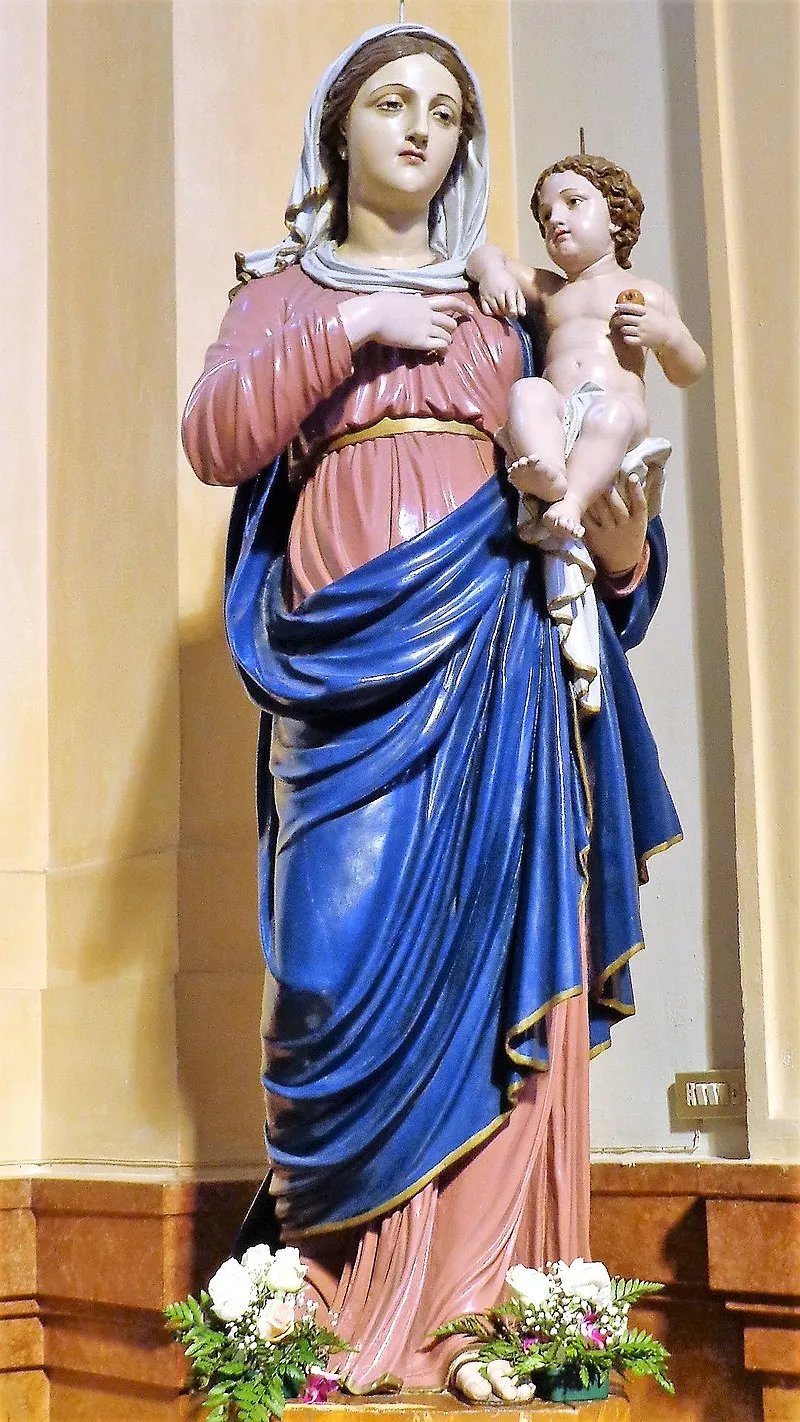
Worship and the Cult of Saint Sebastian
Origins and Significance of Saint Sebastian
The name Sebastian is derived from the Greek word “Σεβαστός” (Sebastos), meaning “worthy of honor, venerable, or imperial.” Saint Sebastian, a Christian martyr from Narbonne, is widely regarded as a protector against epidemics, particularly the bubonic plague. His cult has deep roots in Sicily, with its origins dating back to around the year 1300. Saint Sebastian, originally from Milan, was considered one of the key intercessors against the plague, alongside other saints such as Saint Rocco, Saint Anthony the Abbot, and Saint Christopher. His image became a symbol of endurance and survival in the face of great suffering.
In the town of Barcellona Pozzo di Gotto, the devotion to Saint Sebastian took hold around the year 1500. The cult of Saint Nicholas of Bari, the town’s previous patron saint, was gradually replaced by that of Saint Sebastian, who became the protector of the village, especially in times of epidemic outbreaks. The transformation of Saint Sebastian into a protector against disease was greatly influenced by his miraculous survival of being shot with arrows. This survival was seen as a divine sign, symbolizing hope and resilience in the face of death.
Saint Sebastian as Protector Against Epidemics
Saint Sebastian’s connection to epidemics, particularly the bubonic plague, is a central aspect of his cult. The Black Death, which ravaged Europe in waves, reached Sicily several times throughout the centuries. The plague struck the island in 1347, 1449, 1524, 1575-1578, and again in 1743, causing widespread suffering and devastation. During these times of fear and uncertainty, Saint Sebastian was invoked for his protection, as his survival from martyrdom was interpreted as a sign that he could protect the faithful from the deadly diseases that swept across the land. In Sicily, the cult of Saint Sebastian spread quickly, particularly in towns with histories of plague outbreaks. The discovery of his relics in Melilli in 1414 played a pivotal role in cementing his status as a protector against disease. The reverence for Saint Sebastian in towns such as Melilli, Palazzolo Acreide, Cassaro, Ferla, and Francofonte further solidified his role as an intercessor against the plague. His cult also spread to Acireale, Mistretta, Palermo, and other towns across the island, establishing a network of devotion to the saint.
The Martyrdom of Saint Sebastian
Saint Sebastian’s martyrdom is one of the most iconic elements of his story. A soldier under the emperors Maximian and Diocletian, Sebastian was known for his unwavering Christian faith, which remained hidden from his superiors for a time. His loyalty and intelligence earned him favor with the emperors, who were unaware of his Christian beliefs. However, Sebastian’s acts of charity, including aiding persecuted Christians and ensuring they received Christian burials, eventually led to his discovery and persecution. Diocletian, who was a staunch opponent of Christianity, condemned Sebastian to death. The first attempt to kill him involved shooting him with a barrage of arrows on the Palatine Hill, a punishment that was meant to be fatal. However, through divine intervention and the care of Saint Irene, Sebastian survived this first martyrdom, making him a symbol of resilience and divine protection. His survival made him an even more powerful figure in the eyes of the faithful.
Following his miraculous survival, Saint Sebastian was subjected to a second martyrdom, this time by flagellation, on the steps of the Temple of Elagabalus. Ultimately, he died from the brutal torture inflicted upon him. His body was then discarded and thrown into the Cloaca Maxima, the ancient Roman sewer system. However, in a miraculous turn of events, Saint Sebastian appeared in a dream to a noblewoman named Lucina, who guided her companions to recover his body and give him a proper Christian burial in the Catacombs of San Sebastiano in Rome.
Symbolism of Saint Sebastian and His Role in Local Worship
Saint Sebastian’s image is commonly depicted in art and religious statues, often showing him tied to a post or a tree, pierced by numerous arrows. This portrayal symbolizes his suffering and the miraculous nature of his survival. His association with arrows has led to his identification as a protector against epidemics, with the arrows symbolizing the diseases that afflict the people.
In Barcellona Pozzo di Gotto, the devotion to Saint Sebastian is particularly strong. An 18th-century wooden statue of Saint Sebastian, housed in the Basilica of San Sebastiano, is an important religious artifact and a focal point for worship. The figure of Saint Sebastian is often seen as a symbol of strength and hope, particularly in times of crisis or illness.
The Plague and the Role of Saint Sebastian in Sicilian Communities
The recurrent plagues that struck Sicily throughout history were devastating, especially in coastal towns where maritime trade made them vulnerable to disease outbreaks. The presence of ports and the movement of ships carrying goods and people from infected areas were key factors in the spread of the disease. During these dark times, towns across Sicily, including Barcellona Pozzo di Gotto, turned to Saint Sebastian for protection. Saint Sebastian’s role as a protector against the plague became especially prominent during the Black Death, which devastated Italy in the 14th and 15th centuries. The island’s communities, devastated by these epidemics, placed their trust in Saint Sebastian, hoping that his intercession would lead to healing and the end of the suffering caused by the diseases. The cult of Saint Sebastian became not only a religious devotion but also a form of collective hope and solidarity during times of widespread illness and fear.
In conclusion, the worship of Saint Sebastian in Barcellona Pozzo di Gotto and throughout Sicily is deeply intertwined with the island’s history of plague outbreaks and epidemics. Saint Sebastian’s miraculous survival and his association with the protection against disease have made him a beloved figure in the region. His role as a defender of the afflicted and a symbol of faith, endurance, and divine intervention continues to resonate with the faithful, ensuring that his cult remains an integral part of Sicilian religious life.
History of the Cathedral of San Sebastiano
Primitive Temple and Early History
The origins of the Cathedral of San Sebastiano date back to the Aragonese-Spanish era, with a primitive temple likely established in the early centuries. The first documented reference to the church of San Sebastiano appears in the 14th century, though some sources suggest its existence could date even further back.
The 16th Century: The Original Cathedral’s Foundation
In 1592, the place of worship is officially documented. The construction of the original cathedral of San Sebastiano took place between 1595 and 1606. This was the initial phase of the cathedral’s establishment as a key religious center.
Architectural Developments in the 17th Century
Around 1650, two renowned architects, Andrea Suppa and Nicola Francesco Maffei, who belonged to the Lombard-Carrarese artistic movement, were involved in redesigning the ancient cathedral. While there is some uncertainty about the specifics, as the historical documentation is limited, these architects likely contributed to the significant changes during this period. The restoration and redesigns aimed to enhance the cathedral’s architectural appeal and structural integrity. In 1731, the archpriest Giovanni Cutrupia of Castroreale recorded the church’s internal arrangement in a chronicle. This document outlined the cathedral’s altars, some of which were transferred to the newly built cathedral in later centuries. Cutrupia describes twelve altars, including one in the chapel beneath the dome dedicated to the Blessed Virgin Mary, and others placed in the transept. Notably, the church of the Agonizzanti, which communicated internally with the cathedral, also housed four additional altars.
The Earthquake of 1783 and Subsequent Restoration
Following the catastrophic earthquake of 1783 in southern Calabria, the cathedral sustained significant damage. In 1795, after extensive renovations, the cathedral was reopened for use on the feast of Pentecost, under the patronage of Saint Sebastian and several other saints.
19th Century: The Risorgimento Era and Expansions
Around 1850, further expansions took place, particularly the incorporation of the church of the Agonizzanti, as documented by Giovanni Cutrupia in his 1731 chronicle. This period also saw significant urban development following the administrative unification of the hamlets of Barcellona and Pozzo di Gotto in 1836, which led to population growth and the need for a larger, more representative temple.
The 20th Century: Earthquake Damage and the Demolition of the Old Cathedral
The early 20th century brought another devastating blow to the ancient cathedral. The Messina earthquake of 1908 caused severe structural damage, making the cathedral unsafe for use. While the building was initially shored up and reopened to serve the faithful, it was ultimately decided that the old cathedral could no longer serve its purpose. In the wake of the earthquake, the urban development of the area took precedence. The ancient cathedral, along with the adjacent church of the Agonizzanti and the Placido Mandanici theatre, was demolished to make way for the construction of modern roads and buildings. The old cathedral had once stood in the square now named after San Sebastiano.
The New Cathedral: A Modern Landmark
The construction of a new cathedral began in the 1930s to meet the needs of the growing population and to serve as a symbolic center of faith. The project was officially approved on 1 April 1931, with construction commencing on 25 January 1932. The new cathedral was completed on 30 October 1935 and inaugurated on 25 March 1936 by Archbishop Angelo Paino. This new cathedral became a prominent feature of the city, representing both a historical and spiritual milestone for the community. In 1992, the cathedral was elevated to the status of a minor basilica by Cardinal Angelo Sodano, further cementing its significance. The modern cathedral continues to serve as a place of worship and a symbol of the city’s resilience, having been rebuilt after numerous calamities.
Demolition of the Old Structures
In 1936, the demolition of both the original cathedral and the church of the Agonizzanti was completed. The area surrounding the cathedral underwent significant urban changes, reflecting the broader shifts in the city’s infrastructure and development.
Architecture of Minor Basilica of San Sebastiano, Barcellona Pozzo di Gotto, Italy
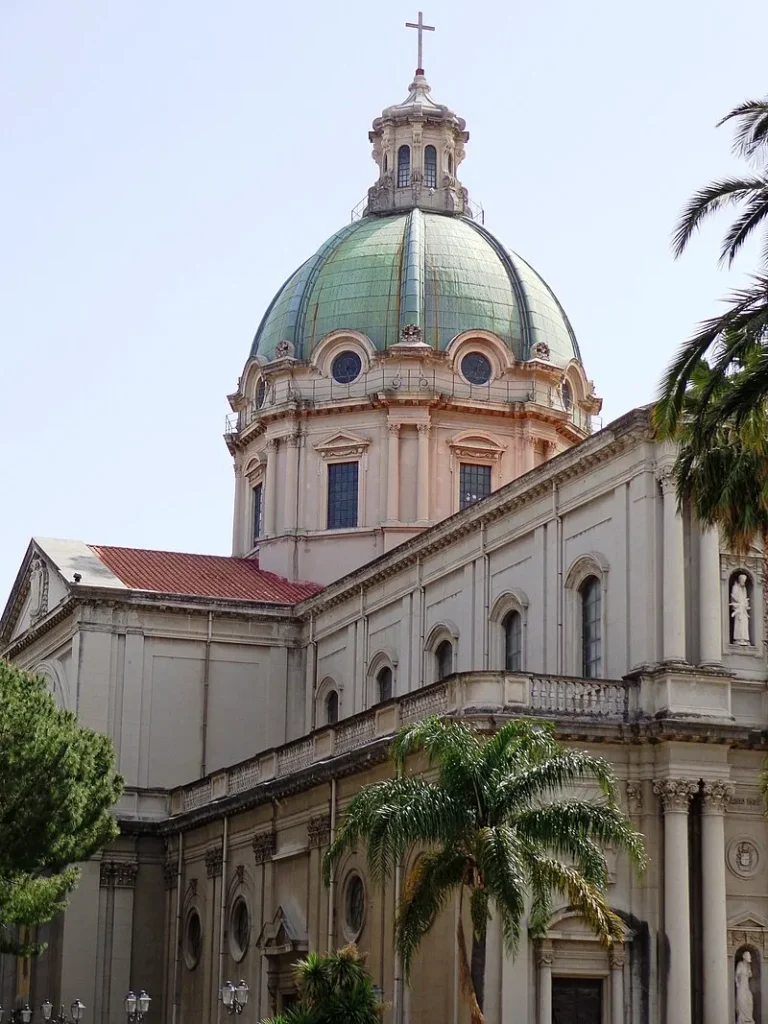
Architectural Style: Neoclassical architecture.
The Basilica of San Sebastiano: Architecture and Design
Background and Construction
Following the administrative merger of Barcellona and Pozzo di Gotto in 1836, which led to a significant increase in population, the need for a larger church became urgent. The old church of St. Sebastian, dating back to 1606, was damaged in the devastating 1908 Messina earthquake, rendering it unusable. Additionally, the old church obstructed the construction of the Via Roma, a major thoroughfare connecting the city to the railway station. In the context of urban renewal, the church, along with the adjacent Chiesa degli Agonizzanti (Church of the Dying), Placido Mandanici Theatre (destroyed by fire in 1967), and the Monte di Pietà, were demolished to make room for the new cathedral. The architectural project for the new basilica was approved on April 1, 1931, and construction began on January 25, 1932. The work was completed by October 30, 1935, and the basilica was inaugurated on March 25, 1936, by Archbishop Angelo Paino of Messina. The completion of the surrounding square and its elevation to the status of a minor basilica by Cardinal Angelo Sodano on September 18, 1992, marked significant milestones in the church’s history.
Architectural Features of the Basilica
Facade
The facade of the basilica is a modern interpretation of neo-classical architecture. Its design draws inspiration from various notable structures, such as the Basilica of Sant’Andrea della Valle in Rome. The facade features two rows of twin columns, each crowned with Corinthian capitals. These columns frame the main window, the central entrance, and the side niches. The central section of the facade is marked by a dynamic and lively design. The eight central columns are positioned slightly ahead of the lateral columns, with the four central columns being even more advanced. This arrangement creates a broken and elevated tympanum, which adds a sense of movement and energy to the structure. Within the tympanum, a frieze is carved with symbols representing cardinal’s insignia, along with a sculpted palm tree between two lions. The coat of arms and the motto “SOLUS CUM SOLO DEO” (translated: “Alone with God Alone”) are linked to the order of Saint Paul.
The entrances and window openings are framed by columns surmounted by triangular, arched tympani. The niches above the columns are topped with triangular, arched pediments.
Statues and Sculptural Details
The niches of the main façade house four statues created by sculptor Domenico Farina. These statues represent Saint Peter, Saint Paul, Saint Francis of Assisi, and Saint Catherine of Siena. The stark contrast between the white marble of the statues and the darker stone from the quarries of Billiemi and Comiso adds visual interest and highlights the detailed craftsmanship.
Inspiration from Other Architectural Works
The design of the basilica’s dome was influenced by Filippo Juvarra’s work on the Basilica of Superga in Turin. The twin ribs of the dome, which were simplified and lightened, mirror the structure of Juvarra’s dome, while still allowing for a unique and modern interpretation in the Barcellona church. The shape, size, and style of the dome also resemble that of the New Cathedral of Brescia, though the latter lacks the small circular windows at the base, which are a defining feature in Barcellona. The terraces above the side aisles are notably wider than those in other similar structures, providing room for the creation of two smaller front entrances. These design decisions emphasize the basilica’s grandeur while addressing practical concerns related to space and access.
Frescoes in the Basilica
The interior of the basilica is adorned with frescoes painted by Gino Colapietro in 1997, which grace the internal wall of the entrance. These frescoes depict significant Biblical scenes that contribute to the spiritual atmosphere of the church. Among the scenes portrayed are The Creation, The Expulsion from Eden (Original Sin), God and the Tablets of the Commandments, and The Baptism in the Jordan. Each fresco offers a visual representation of key moments in Christian theology, adding depth to the basilica’s religious significance and enriching the visitor’s experience.
Interior of the Basilica
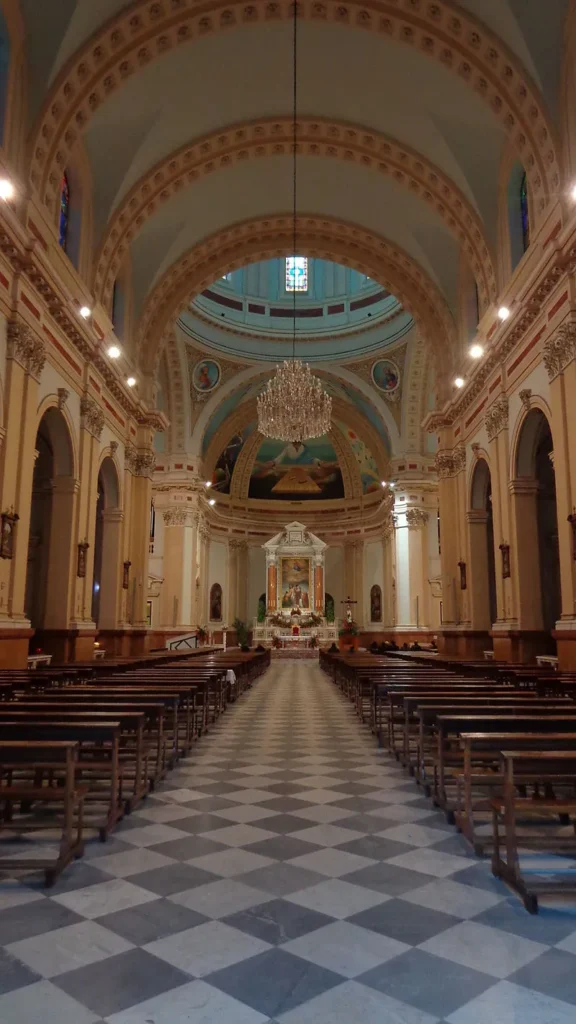
The interior of the basilica is designed in the shape of a Latin cross, featuring a large central nave with a barrel vault. This vaulted ceiling is beautifully adorned with friezes, rosettes, and stuccos. The church is divided into three main naves, supported by strong pillars that hold large arches, which are enhanced with twin pilasters. The central nave is the focal point of the interior, measuring approximately 25 meters in length, 16 meters in width, and 23 meters in height, both visually and acoustically standing as the defining architectural element of the church. The basilica also has spacious lateral naves, each with five arches, each topped with a Byzantine-Arab inspired dome. These side aisles house six altars and two lateral entrances.
Right Aisle (South Side)
The Right Aisle (South Side) of the basilica showcases a rich array of altars and significant historical elements. The first span commemorates the church’s elevation to basilica status, highlighted by a marble inscription of Pope John Paul II’s papal bull from 1989. This was formally celebrated during the elevation ceremony in 1991 and the dedication in 1992. Moving to the second span, the Altar of Our Lady of the Dying (Madonna degli Agonizzanti) stands as a fine example of Baroque artistry, featuring an altarpiece that portrays the Virgin Mary surrounded by saints. The altar’s ornate design includes pilasters and a Roman-style tabernacle. The third span houses the south-side entrance to the basilica. In the fourth span, the Altar of Saint Joseph, adorned with a 1942 painting by Santa Rugolo, highlights a figure of Saint Joseph with the Child Jesus. Finally, the fifth span showcases the Altar of Our Lady of Graces (Madonna delle Grazie), dedicated to the city’s patron saint. This altar is a treasured piece from the old cathedral, featuring a statue of the Virgin Mary and framed with pilasters and a symmetrical arched pediment.
Left Aisle (North Side)
The left aisle (north side) of the basilica features several notable altars and commemorative elements. In the first span, the baptismal font was originally placed here, though it has since been moved closer to the main altar. Commemorative plaques on the wall document the church’s dedication on March 25, 1936, and its official consecration on June 8, 1986. The second span houses the Altar of Saint Anthony of Padua, a modern marble creation from 1940, which includes pilasters, a symmetrical broken pediment, and a statue of Saint Anthony placed in a niche. The third span leads to the north-side entrance. In the fourth span, the Altar of the Triumph of the Cross, originating from the old cathedral, features a painting by Filippo Jannelli depicting Jesus and Mary, celebrating the Triumph of the Cross. This altar is framed by pilasters, a symmetrical arched pediment, and a valuable marble antependium. Finally, the fifth span holds the Altar of the Sacred Heart of Jesus, another altar from the old cathedral, which is distinguished by double pairs of columns and a projecting symmetrical pediment. The central altarpiece, depicting the Sacred Heart of Jesus, is elegantly framed within this structure.
Transept and External Works
The transept of the basilica is home to several significant religious and artistic features. In the south transept, a modern marble altar designed by Antonino Antonuccio stands in classical style, supported by twin pilasters with Corinthian capitals and a symmetrical pediment with downward volutes. Above the altar is an 18th-century wooden statue of Saint Sebastian, which is used during the procession on January 20. Over the choir, a 17th-century painting depicts scenes from the life of Saint Christopher. The northern wall of the transept showcases a fresco titled The Miraculous Shoal of Fishes, created by Gino Colapietro in 1994. The fresco features characters modeled after local citizens, with the archpriest’s face notably included. Beneath the fresco are three valuable confessionals crafted by the local cabinetmaker Antonio Genovese in the 1960s. Additionally, a painting of the Virgin and Child with Saint Francis, created by Gaspare Camarda in 1606, is displayed.
In the transept, four mosaics by Claudio Traversi depict key biblical events: The Annunciation, The Nativity, The Adoration of the Magi, and The Presentation of Jesus at the Temple. On the exterior walls of the transept, mosaics of Saint Nicholas of Bari (on the south side) and Saint Francis of Paola (on the north side) are featured. Near the Saint Nicholas mosaic, there is a bronze statue of Saint Pio of Pietrelcina, created in 2001. An important external work of the basilica is the Column of the Immaculate Conception, located to the right of the churchyard when facing the facade. This column is a significant symbol of Sicily’s devotion to the Virgin Mary, particularly in relation to the dogma of the Immaculate Conception. Annually, on December 8, the feast of the Immaculate Conception is celebrated with a solemn mass in the basilica, and floral tributes are placed at the base of the monument.
High Altar
The main altar of the basilica is a magnificent structure crafted from polychrome marble, designed in the form of a Roman temple. The elevation of the altar features a symmetrical double broken pediment with a central commemorative stele, commonly referred to as an entrecoupé pediment. This design mirrors the architectural style of the church’s façade. Between the columns, which are adorned with Corinthian capitals, is a canvas painting depicting the Martyrdom of Saint Sebastian. The scene includes Saint Irene of Rome, portrayed in mourning as she retrieves the body of the martyr, accompanied by her maid and Saint Nicholas of Bari, who kneels beside her. This composition, created by Giacomo Conti in 1879, is completed by an image of the Madonna in Glory. The Madonna is depicted with the Madonna delle Grazie, the co-patroness of the city, surrounded by a host of angels, cherubim, seraphim, thrones, and dominations. This grand marble altarpiece was created by Salvatore Manganaro under the direction of Maria Mento and Angela Mento, and it was completed in 1960.
Above the altar, the Christ Pantocrator fresco dominates the apse dome. Painted by Filippo Minolfi in 1984, this powerful image of Christ as the ruler of the universe adds to the grandeur of the church’s interior. The basilica also houses several canvases from the 17th and 18th centuries, with notable works such as the Madonna del Carmelo and Saints, the Madonna del Rosario, and the Mystical Marriage of Saint Rose, which depicts the Madonna between Saints Cosma and Damiano and Saint Rose. Some of these works are attributed to Filippo Vescosi and Antonino Vescosi, who were active in the late 18th and early 19th centuries.
Doors of the Basilica
The basilica’s main entrance is marked by three striking bronze doors, which replaced the original wooden doors. The central door, designed by Ennio Tesei, features six panels depicting scenes from the life of Saint Sebastian, including his first martyrdom with arrows, his second martyrdom with flogging, and his eventual care by Saint Irene. The panels also include symbolic representations of martyrdom, such as the palms of martyrdom used as handles for the door, as well as depictions of Saint Sebastian’s sermons, his encounter with Emperor Diocletian, and the Cloaca Maxima. Above the door is a festooned frieze bearing symbols of martyrdom, including arrows, a crown, and a palm, all created in 1990. To the right of the main entrance, a second bronze door, crafted by Giorgio Luzzietti, features panels showcasing key Biblical scenes like Pentecost, the Ascension, the Multiplication of the Loaves and Fish, the Miraculous Catch of Fish, the Wedding at Cana, and the Resurrection of Lazarus. The third door, to the left, was designed by Claudio Traversi in 1991 and depicts the Great Flood, the Tablets of the Law, the Burning Bush, the Church of the Basilians, the ancient Cathedral of Saint Sebastian, the new basilica, and a panel dedicated to Monsignor Angelo Paino, known as “The Rebuilder.” These artistic doors not only serve as functional entrances but also as significant representations of faith and history, each narrating essential moments of Christian and local heritage.
Dome
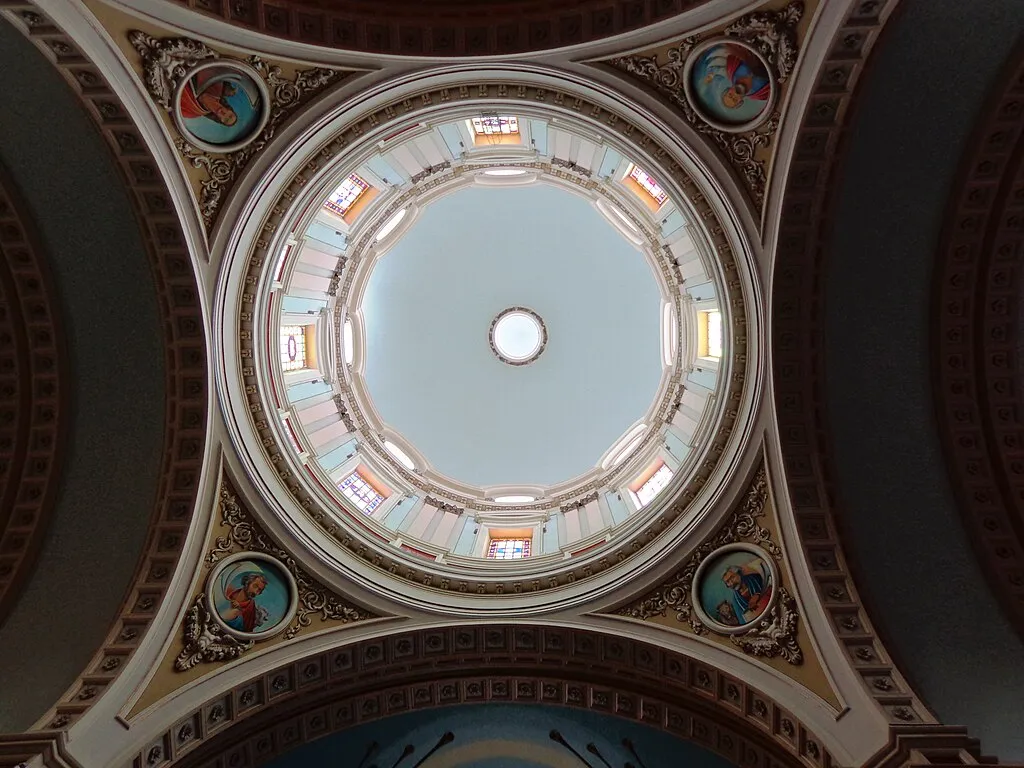
The dome of the basilica is a striking feature, symbolizing the church and the city. Measuring 16 meters in diameter and 8 meters in height, it is crowned by a small octagonal lantern. The dome is illuminated by eight windows arranged around its drum and by eight oculi located on the base of the dome. It rests on a high octagonal drum, which is surrounded by eight rectangular windows. These windows are separated by ribs, which are supported by pairs of coupled columns. At the base of each rib, there are shells containing doves, a symbol of the Holy Spirit. Inside the dome, the pendentives at the base of the drum are adorned with the four Evangelists—Matthew, Mark, Luke, and John—painted by Filippo Minolfi in 1986. The stained glass windows on the drum of the dome were created in the early 1990s by Salvatore Gervasi, adding to the overall beauty and spiritual significance of the basilica’s interior.
The Dimensions and Renovations
The Basilica of San Sebastiano, located in the province of Messina, is the second-largest Catholic church in the region, renowned for its impressive architectural dimensions. The church features a maximum external length of 72 meters, with a nave height of approximately 23 meters and a dome height of 20 meters, supplemented by an additional 18 meters from the drum, hemisphere dome, and lantern with a cross. The side aisles reach a height of 12 meters, and the facade stands at 25 meters, while the bell tower reaches 32 meters in height. The basilica’s maximum external width is 39 meters, with the central nave spanning 16 meters in width and the chapels each measuring 5 meters across. The total building surface area is around 2,000 m², including ancillary rooms. Over the years, the basilica has undergone various renovations, particularly after its elevation to minor basilica status. Notable changes include the removal of the original front staircase, reorganization of the altar with a new altar table facing the congregation, and the replacement of old windows with beautiful historiated stained glass. New chapels, such as the Chapel of the Confessions and the Chapel of the Blessed Sacrament, were built in 2000, and several interior spaces, including the presbytery and rectory, were redesigned. Additionally, a wooden choir platform was added to the right transept during these renovations.
Stained Glass Windows
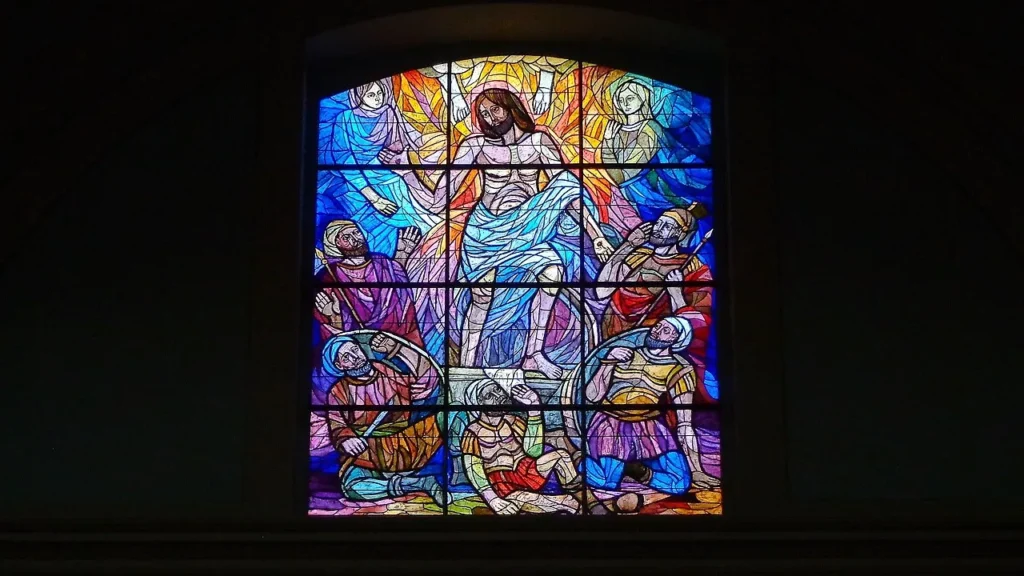
The Basilica of San Sebastiano is renowned for its stunning stained glass windows, which are not only artistic treasures but also significant religious symbols. These windows, designed by various artists over the years, bring to life key biblical scenes and saints, adding to the basilica’s spiritual atmosphere. The apse windows, designed by Lindo and Alessandro Grassi in 1970 and Cupelloni in 1992, feature the Sacred Heart and the Immaculate Heart of Mary. The main facade window displays an image of Saint Sebastian, also created by the Grassi brothers. Inside, the central nave windows, crafted by Father Alberto Farina in 1991, depict scenes such as the Resurrection, the Crucifixion, and various saints, including Saint Thomas, Saint Dominic, Saint Francis, and Saint Agatha, among others. The round chapel windows, designed by Claudio Traversi in 1992, portray religious figures like Saint Joseph, the Holy Spirit, and the Triumph of the Cross. Additionally, the dome drum features eight rectangular windows by Salvatore Gervasi, further enhancing the grandeur of the basilica. These stained glass windows not only brighten the space but also serve as a visual narrative of the church’s deep religious heritage.
Choir and Fresco
The choir of the Basilica of San Sebastiano is a beautiful feature, composed of classical-style wooden seats that create a serene and sacred atmosphere. Constructed in September 1985 by Santi Diletti and designed by Angela and Maria Mento, the choir is situated within the presbytery. Its elegant design contributes to the overall aesthetic of the basilica, enhancing its liturgical and ceremonial functions. A prominent fresco by Gino Colapietro, created in 1997, graces the counterfaçade of the choir area. Titled Baptism in the Jordan, the fresco adds a profound spiritual element to the space, deepening the religious significance of the basilica’s interior.
Organ
The organ of the Basilica of San Sebastiano, crafted by the Tamburini company of Crema in 1967, is a remarkable example of organ-making. This instrument, regarded as the second-largest organ in the province after that of the Cathedral of Messina, is situated in the choir transepts, specifically in the Cornu Epistulae and Cornu Evangelii. With a total of 2,760 pipes, the organ’s expansive console features three keyboards, 61 keys, and a 32-pedal pedalboard, offering 41 real sound registers. Known for its exceptional tonal quality, the organ enhances the acoustics of the basilica, playing a pivotal role in both liturgical ceremonies and musical performances.
Bells
In 1989, the Basilica of San Sebastiano introduced a new set of nine bells from the Capanni foundry in Catania. These bells replaced the old ones from the previous church and were meticulously tuned to produce gradually decreasing tones, ensuring a harmonious and rich sound. The largest bell has a diameter of 109 cm. The first three bells are equipped with spread-out hammers, enhancing their resonance. In addition to the bells, a carillon clock was installed, featuring four dials, each measuring 169 cm in diameter. This clock not only adds a functional timepiece to the basilica but also enhances its aesthetic presence on the exterior.
Sacristy and Archpriests of the Basilica of San Sebastiano
The sacristy of the Basilica of San Sebastiano, located beside the presbytery and accessible through both the ambulatory and transept, holds numerous historical and religious treasures. Among its most significant items are the sarcophagus of Giovanni Spagnolo (1791), which commemorates the philanthropist, and ten 18th-century canvases depicting scenes from the life of Saint Sebastian, attributed to Giovanni Andrea Jannelli. The sacristy also houses an 18th-century reliquary, an organ casing with intricate wooden carvings from the early 18th century, and several marble plaques honoring Raimondo de Moncada, the Bishop of Patti from 1782 to 1813. These relics, along with other items, reflect both the artistic and spiritual heritage of the basilica. Additionally, the archpriests who have served at the basilica play a crucial role in its ongoing legacy, overseeing the spiritual life of the community and maintaining the ecclesiastical duties of the parish. The archpriests include figures like Nunziato Bonsignore, Monsignor Domenico D’Arro, and Father Francesco Farsaci, who has served since 2001. Moreover, the basilica is rich in local traditions, including the historic practice of throwing chickpeas at the statue of Saint Sebastian during the January 20th processions as a form of devotion, a custom now discontinued by the ecclesiastical authorities. The festival also features the making of Ciaurrina, a traditional candy symbolizing the martyrdom of Saint Sebastian. One of the most revered relics of the basilica is U Brazzu di San Bastianu, the forearm bone of Saint Sebastian, which is invoked in local sayings as a call for divine intervention in times of need.
Feast Day
Feast Day : 20th January
The feast day of Saint Sebastian, celebrated at the Minor Basilica of San Sebastiano in Barcellona Pozzo di Gotto, Italy, is observed on January 20th. This day honors Saint Sebastian, the patron saint of the basilica, with processions and various local customs.
Church Mass Timing
Monday : 9:00 AM , 6:00 PM.
Tuesday : 9:00 AM , 6:00 PM.
Wednesday : 9:00 AM , 6:00 PM.
Thursday : 9:00 AM , 6:00 PM.
Friday : 9:00 AM , 6:00 PM.
Saturday : 9:00 AM , 6:00 PM.
Sunday : 9:00 AM , 11:00 AM , 6:00 PM
Church Opening Time:
Daily : Open 24hrs
Contact Info
Address :
Piazza Duomo, 7, 98051 Barcellona Pozzo di Gotto ME, Italy
Phone : +390909795319
Accommodations
Connectivities
Airway
Minor Basilica of San Sebastiano, Barcellona Pozzo di Gotto, Italy, to Reggio Calabria Airport (REG), distance between 1 hr 33 min (71.9 km) via A20/E90.
Railway
Minor Basilica of San Sebastiano, Barcellona Pozzo di Gotto, Italy, to Barcellona – Castroreale Barcellona Pozzo di Gotto, distance between 7 min (2.9 km) via Corso Sicilia and SP75.

